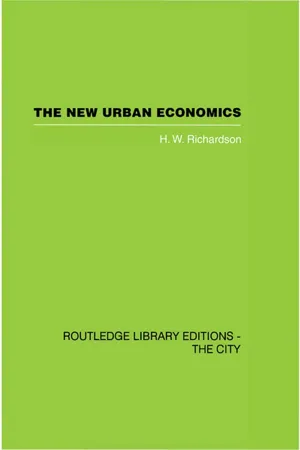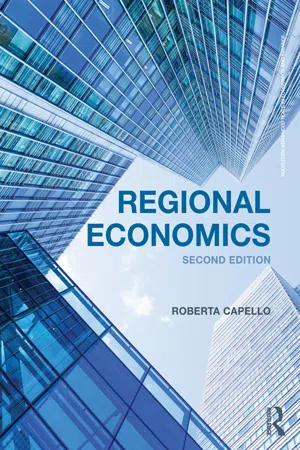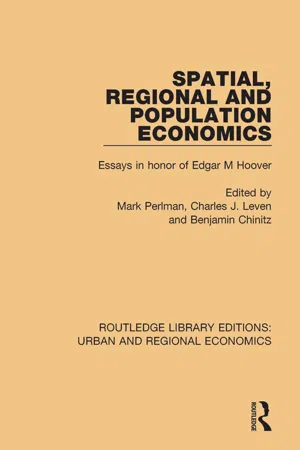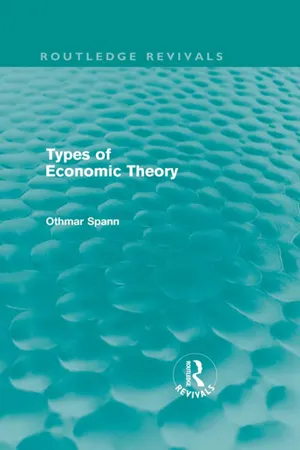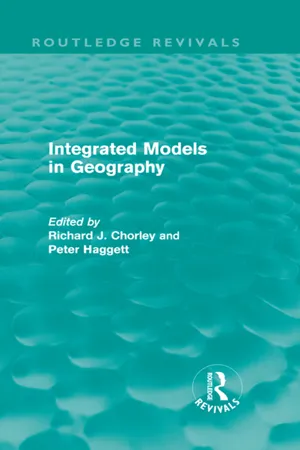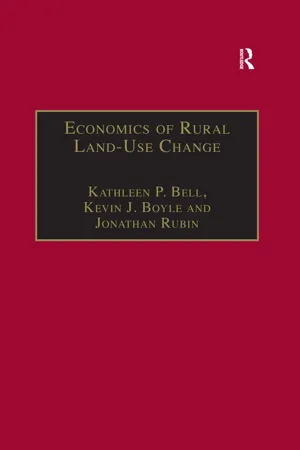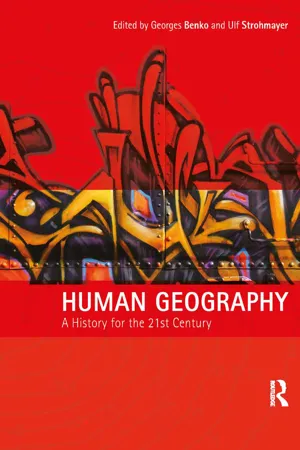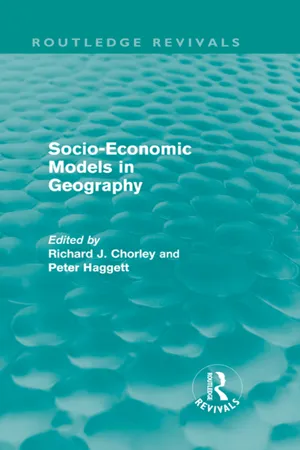Geography
Von Thunen Model
The Von Thunen Model, developed by German economist Johann Heinrich von Thunen in 1826, explains the spatial arrangement of agricultural land around a central market. It suggests that different types of agricultural activities are located at varying distances from the market, with transportation costs and land rent influencing land use patterns. This model provides insights into the organization of agricultural landscapes and the economic principles governing land use.
Written by Perlego with AI-assistance
Related key terms
10 Key excerpts on "Von Thunen Model"
- eBook - ePub
- William P. Anderson(Author)
- 2012(Publication Date)
- Routledge(Publisher)
(Recall that site attributes are those physical characteristics of a particular location that make it advantageous for some economic activity.) Another nineteenth-century economist, Johann Heinrich von Thünen, devised an alternative theory of land rent based on situation attributes. (Recall that situation attributes refer to the accessibility of a place.) As a landowner himself, von Thünen observed that land rents varied significantly even within regions where the physical characteristic of the land varied little. Through careful observation, he discovered that these rent variations could be explained based on the accessibility of different plots of land to market towns. He extended this observation into a formal model not only of spatial variation in rents, but also of spatial patterns of different types of farming. Von Thünen’s model is a foundation stone of economic geography. Not only is it one of the earliest economic models with an explicitly spatial expression, but its basic logic has been extended beyond agricultural land use to help explain urban land-use patterns, as we will see in chapter 18. Von Thünen's model As always, the best way to start discussing a model is by listing its assumptions: All agricultural activity takes place on an undifferentiated plain. That means there is no variation from place to place in soil quality, weather, slope or any other factor that might affect agricultural productivity. At some point in the plain there is a single, isolated market town. All crops produced in the plain must be transported to this market town (hereafter “the market”) for sale. Market prices are assumed to be given (exogenous). Transportation costs for crops produced at any point on the plain are a fixed rate times the distance to the market. The transportation rate may vary across crops. The entire plain is under the ownership of landlords who rent their land to farmers - eBook - ePub
The New Urban Economics
And Alternatives
- H.W. Richardson(Author)
- 2013(Publication Date)
- Routledge(Publisher)
von Thünen's agricultural model has been discussed by Hall (1966), Beckmann (1968), Artie and Varaiya (1974 ; 1975), Scott (1975c), and Guigou (1972), and Beckmann (1972) has developed an interesting urban version. von Thünen's own model was abstract, though it was illustrated with numerical examples using data from his own estate (Tellow). His assumptions included: the town is located on a homogeneous plain with land of equal quality; there is no spatial differentiation within the town, hence it can be treated as a single point; landlords maximize profits; they have complete information about production methods, prices, and transport costs; all prices and transport costs are fixed; there are no intermediate goods, and hence no production linkages; and production costs are constant over space. In fact, the model was a little more complicated, in at least two respects. First, his formula for estimating transport costs was based on the assumption that the feed of horses and food for drivers had to be carried along implying a nonlinear transportation function. Second, he assumed that real wages were constant over space, and divided wages up into a 'real'-wage component paid in kind (grain) and a money-wage component. These complications are ignored here. Considering the most simple example of a von Thünen type model, land rent may be defined as revenue minus costs, and costs can be divided between production costs and transportation costs - eBook - ePub
- Roberta Capello(Author)
- 2015(Publication Date)
- Routledge(Publisher)
As the categories of farmers compete for the more accessible land, each unit of surface area will be allocated to the category willing to pay the highest rent for that land. As far as a’, the land will be allocated to category A, who offers the highest rent for the most central locations, from a’ to b’ to category B, and from b’ to c’ to category C : the actual rent realized by the landowner from cultivation of his land is the envelope of the three rent supply curves. It is interesting to ask where, within each area attributed to a category of farmers, a single farmer will locate. The reply is that farmers will be indifferent to whatever location; that is, they will not compete with one another, since each location guarantees the same level of (normal) profit; by moving towards the village, in fact, transportation costs decrease for the exact amount that is necessary to pay a higher rent. One of the main strengths of this model is its ability to demonstrate that it is simple distance from, or accessibility to, the town (expressed by transport costs) that accounts for differences in land rent. It thus departs from the classical Ricardian view that differences in land profitability are due to different degrees of fertility. 7 By so doing, it is able indirectly to explain the location of economic activities in space – a result that is a significant achievement. 8 In this perspective, the Von Thünen model can be defined as a general spatial equilibrium model. Starting from the assumption of a homogeneous space (an un-cultivated plain), and giving for granted a normal profit level, common to all categories of farmer, the model is able to identify at the same time the location of the different categories and the rent level. 2.3 The urban location of firms: the Alonso model In the early 1960s, first William Alonso and then Richard Muth reconsidered von Thünen’s model and adapted it to an urban context, 9 thus paving the way for numerous subsequent studies - eBook - ePub
Spatial, Regional and Population Economics
Essays in honor of Edgar M Hoover
- Mark Perlman, Charles J. Leven, Benjamin Chinitz(Authors)
- 2017(Publication Date)
- Routledge(Publisher)
7Thünen, Weber and the Spatial Structure of the Nineteenth Century CityRAYMOND L. FALES and LEON N. MOSES* †Northwestern University, Evanston, Ill., and Livingston College,Rutgers University, New Brunswick, New JerseyEconomists, geographers, and a number of theoretically inclined planners have developed models to explain patterns of urban land use and rent.1 Many of these models are adaptations of J. H. Von Thünen’s theory of agricultural location.2 The more rigorous of them assume a central area in which all production and employment take place, and through which all imports and exports move. The land pattern is depicted as a series of concentric zones of exclusive and progressively less intensive use. The models replicate what is taken to be the usual order of urban land use. The business area is followed by a manufacturing zone and the latter by one devoted to residences. Finally, there is an agricultural zone. Land rents fall continuously with distance from the center of the city.This essay grows out of some dissatisfaction with these models which seem designed to explain land use in a stereotype of the large, densely settled city of the 19th century. They provide little insight into the spatial structure of places like Phoenix, Albuquerque, and Los Angeles which experienced their major growth in the present century. In these cities, population densities are low and rather uniform. Industry, including banking and other services that are often assumed to be core oriented, tends to be broadly dispersed. Even if such cities have an area that can be identified as the core, it is surely not the focus of all economic, recreational, and other activity. Similarly, Thünen-type models do not seem capable of explaining the massive rearrangements of population and employment that are taking place in urban areas such as Chicago, Boston, and Philadelphia. These are examples of cities that took form and experienced their major growth in the nineteenth and the first two decades of the present century. However, powerful forces have been causing a dispersal and intermixing - eBook - ePub
- Othmar Spann, Eden Paul, Cedar Paul(Authors)
- 2013(Publication Date)
- Routledge(Publisher)
Thünen's zonal theory is still the most outstanding theoretical foundation of agricultural practice. It is, of course, only true upon certain assumptions which can never be wholly realised—upon the assumption of a homogeneous soil and of homogeneous transport conditions. Still, actual experience often furnishes close approximations to Thunen's imaginative picture. Any one who leaves a great city by train can see for himself the innermost zone of horticulture and market-gardening. Going back into history, we find that in the Middle Ages the great towns were encircles by zones showing Thünen's succession of agricultural methods. We can trace this, for instance, in the environs of Berlin. The reason why such a schematisation no longer holds good, is that the growth of railways and the development of other means of cheap transport have brought remote places into close touch with the market. (South America supplies Germany with grain.) Consequently Thunen's idea of zonal localisation no longer applies to the environs of particular towns; but it does apply in broad lines to the aggregate system of countries having intimate trade relations one with another. Thickly populated and predominantly industrial lands like England and Germany have become markets for distant, thinly populated, and mainly agricultural lands. The result is that, round the great towns of the present day, only the first, the proximate zone, is clearly recognisable. Take Vienna, for which this zone is comprised by the whole of Lower Austria, southern Moravia, and northern Styria, whence the Austrian capital is supplied with green vegetables, milk, etc - Richard Chorley, Peter Haggett(Authors)
- 2013(Publication Date)
- Routledge(Publisher)
Fig. 14.3 ). The close connection between the von Thünen model and marginal economic theory makes the model a powerful tool when applied to dynamic conditions. Although the gravity model can easily absorb changes over time in the inputs to give fairly reasonable predictions of future interaction between communities or sectors, the theoretical underpinnings of the gravity model are not entirely clear and, therefore, the application of the model to explain dynamic conditions is less powerful than the von Thünen model (Lowry, 1964; Warntz, 1959).14.3 The changing pattern of inhabited settlements in inner North Sweden, 1800–1950,A major difficulty of comparative statics is that the time factor remains external to the model itself, so that although the model shows how a certain set of changes over time will automatically result in spatial adjustments, it does not in itself allow a truly dynamic interpretation of change over space. It assumes that there are no independent processes of change which are not somehow subsumed in the original inputs. Thus notions of growing economies of scale and specialization, agglomeration economies, or even straight conversion cost, are excluded from a von Thünen model used in a dynamic setting. Such processes may mean a mere time-lag in the achievement of a static spatial equilibrium, and therefore such processes may be unimportant in the long-run. The utility of Weber’s theory for explaining long-run locational change in iron and steel production demonstrates this point. But in some cases the actual processes of change will affect the long-run spatial pattern. Processes of agglomeration and cumulative change for example, may be fundamentally important to agricultural change (Harvey, 1963) and in such cases a dynamic von Thünen model will be inappropriate. At best, therefore, comparative statics- eBook - ePub
- John M. Hartwick(Author)
- 2015(Publication Date)
- Routledge(Publisher)
Basic land-use theory (Von Thunen theory) is about allocating competing activities to sites. In the absence of externalities, site boundaries for the competing activities shift until an allocation is compatible with a rent function that has no jumps at the spatial boundary. In addition one can envisage competing activities as competing at every site for the space in question: the highest bidder wins and this outcome is part of the definition of an efficient use of the sites. These ideas come out of the classical Von Thunen Model of allocating crops to areas for an efficient use of land.Urban economics borrowed from the Von Thunen Model and developed a model of a city with all jobs at the center and the residences of workers in an area surrounding the center. At the spatial edge, agricultural activity and residential activity compete for sites in a Thunen-like fashion. The generation of an equilibrium land-rent function becomes a central focus. The rent or annual charge on land becomes a sort of puzzle piece that when inserted in a household’s utility maximization problem leaves the household in a utility maximizing equilibrium. When we bring the correct land-rent function to each resident of our city, each household maximizes its utility “correctly” and similar households are on the same indifference curve. Or one might think of the equilibrium of many similar households becoming “closed” by the presence of the appropriate land-rent function. Thus a characterization of land-use economics is finding the appropriate rent function. Central to the locational equilibrium of a household is the “cost” of an equilibrium shift in location: a small shift in the location of the household farther from the center involves a cheaper home (land rent declines with distance from the center) but a marginally more costly commute. And the bottom line is: von Thunen analysis plus basic textbook consumer theory allows us to create fairly plausible-looking cities, on paper. We have left open the question of why so many jobs in cities are clustered in a central area (a central business district). This question has no simple unique answer. We will return to this matter of the clustering of jobs many times in this book.The “open-city” assumption involves very similar worker-households ending up with the same utility in different cities. And two cities of different sizes under the open-city assumption will in general have similar workers with different wages—an odd outcome, at first glance, but one supported by much empirical evidence. The larger city will generally have similar workers earning higher wages but these better paid workers will be facing, on average, higher housing prices in the larger city. This trade-off of higher wages versus higher residential costs allows similar workers to end up on the same indifference curve in two different cities, one large and one small. - eBook - ePub
- Kevin J. Boyle, Jonathan Rubin, Kathleen P. Bell(Authors)
- 2017(Publication Date)
- Routledge(Publisher)
Chapter 6 , which date back to von Thünen's (1826) spatial model of land use in the mid-19th century. Von Thünen's key insight, that differences in transportation costs are capitalized into land values and generate a spatially heterogeneous pattern of land rents, underlies the classic urban bid-rent model developed by Alonso (1964) and Muth (1969). Differences in urban land rents are explained by differences in households' costs of commuting to a centrally located employment center. Given that the costs of commuting to a central business district (CBD) are an important component of a household's budget, a household's net income decreases with increasing distance from the CBD and the rent the household is willing to pay will be lower at a location that is farther from the CBD than at a location nearer to the center. This generates the downward-sloping 'bid rent gradient,' in which urban land rents are hypothesized to decrease with distance from the CBD, that is a key component of empirical models of urban land use. Other theoretical models that also build on the von Thünen approach and that have provided a basis for empirical models include Barlowe (1958), Found (1971), and Capozza and Helsley (1989).While empirical models of land use and land-use change have a common theoretical underpinning, the structure of the models varies according to the data used for estimation and the research question. For example, aggregate data of land use, e.g. at the county-level, are often times the only data available to a researcher and therefore the empirical model is oriented to explaining land use and land-use change at a regional level rather than at an individual parcel level. In other cases, randomly-sampled plot-level data may be necessary to explore plot-level determinants of land-use change, e.g. the importance of on-site physical characteristics such as soil type and slope as well as location features such as spillover effects from surrounding land uses. On the other hand, if the contiguous spatial pattern of land use is the primary research interest, then a complete dataset of the entire population of parcels within a geographic region – rather than just a random sample – would be important. These considerations suggest the following categorization of empirical models: (1) aggregate data models, (2) sample plot data models, and (3) parcel data models. In this chapter, we provide an overview of these models and a discussion of related econometric and modeling issues. - eBook - ePub
Human Geography
A History for the Twenty-First Century
- Georges Benko, Ulf Strohmayer, Georges Benko, Ulf Strohmayer(Authors)
- 2014(Publication Date)
- Routledge(Publisher)
Principles of Political Economy and Taxation was first published in 1817), paid little or no attention to the geographical dimension. Even in his magisterial analyses of comparative advantage and differential rent – where geography potentially might have played a major role – the spatial dimension is reduced to a mere cipher. His theory of comparative advantage, for example, was more or less blind to the subtleties of geographical variation and simply reduced countries to aspatial containers of endowments. Further, as Ponsard (1958) has pointed out, Ricardo based his theory of differential rent largely on variations in soil fertility so that the spatial character of transport costs as generators of locational diversity was lost entirely. In the words of Dockès (1969), ‘the abundant flow of ideas integrating the spatial and economic perspective disappears almost entirely in the nineteenth century like a river vanishing in a desert’. Even Marx, the great polymath of the mid-nineteenth century, was more or less indifferent to spatial issues, and as the century wears on, the principal concerns of the leading writers on economics (Jevons, Menger and Walras, above all) become yet more remote from geography. The goal of economic science at this point is directed primarily to formulating a coherent abstract theory of markets and economic equilibrium.Hence only in a few isolated cases do we find much attention being paid to spatial matters at this time. One of these cases is represented by Alfred Marshall (1890), who, in a few fleeting (but visionary) passages, remarks on the significance of industrial districts and external economies as foundations for today what we would call regional competitive advantage. Another is the German engineer-economist Wilhelm Launhardt, whose article ‘Die Bestimmung des zweckmässigsten Standorts einer gewerblichen Anlage’ (‘Determination of the optimal location of an industrial establishment’), published in 1882, points the way to location theory. Launhardt’s book, The Principles of Railway Location - Richard Chorley, Peter Haggett(Authors)
- 2013(Publication Date)
- Routledge(Publisher)
Chapter Eleven Models of Agricultural Activity Janet D. Henshall A General Model The study of agriculture has interested some of the most able members of our profession. Pioneer works by such men as O. E. Baker, Olaf Jonasson, Clarence F. Jones, Samuel van Valkenburg and Griffith Taylor published in Economic Geography in the inter-war period have been seen as the greatest contribution of that journal to our subject (Buchanan, 1959, p. 6). These studies of the agricultural regions of the world established the broad pattern, and they were followed by numerous empirical papers on agricultural land use analysing the unique causes of patterns within a specific area. According to the most recent overviews of agricultural geography (McCarty, 1954; Buchanan, 1959; Reeds, 1964) we have advanced little in our methods during the forty years since Baker’s paper of 1926. The urgent need for more research is recognized by our famine frightened world, yet in 1964 it could still be said, ‘Agricultural geography has not yet advanced beyond a primitive stage of development simply because many studies have been superficial investigations of extensive areas’ (Reeds, 1964, p. 52). If we are to make the leap forward into maturity we must take a fresh look at our data, concepts and methods. In the past work was often limited by a shortage of published data. Today there is a vast amount of detailed information available for most parts of the world but Coppock’s (1964B) Agricultural Atlas of England and Wales is one of the very few examples of a geographical study utilizing this data bank. Recent work in theoretical geography has influenced our conceptual approach to agricultural problems
Index pages curate the most relevant extracts from our library of academic textbooks. They’ve been created using an in-house natural language model (NLM), each adding context and meaning to key research topics.

